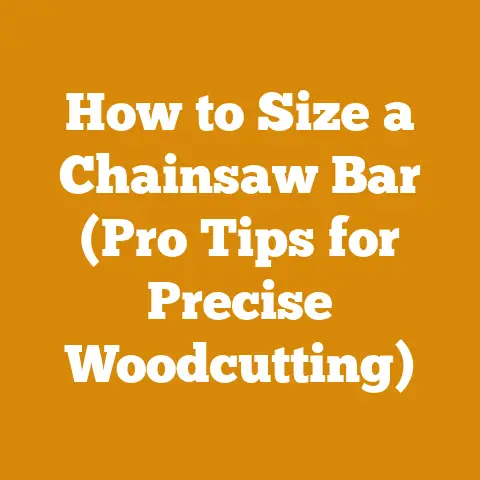Can You Put Aluminum Foil on Grill Grate? (Pro Woodfire Tips)
Ever been in a situation where you’re ready to grill, the coals are hot, the steaks are seasoned, and then… you realize your grill grate is a disaster? Maybe it’s coated in stubborn residue, or perhaps you’re dealing with a rusty old grate that’s seen better days. In a moment of desperation, the thought crosses your mind: “Can I just slap some aluminum foil on this thing and call it a day?”
I’ve been there. I’ve spent years working with wood, from felling trees to splitting firewood and even experimenting with wood-fired cooking. And I’ve learned that shortcuts, while tempting, often come with consequences. So, let’s dive into the question of using aluminum foil on your grill grate, explore the pros, cons, and safer, more effective alternatives for achieving that perfect wood-fired flavor.
The Aluminum Foil Dilemma: A Deep Dive
The allure of using aluminum foil on your grill is understandable. It seems like a quick fix, a way to avoid scrubbing, and a potential barrier between your food and a questionable grill surface. But before you reach for that roll, let’s break down the reality.
Why People Consider Aluminum Foil
- Ease of Cleaning: This is the big one. Foil creates a disposable surface, meaning less scrubbing after your BBQ.
- Preventing Food from Sticking: Foil can act as a non-stick barrier, especially useful for delicate items like fish or vegetables.
- Protecting the Grill Grate: If your grate is old or rusty, foil can seem like a way to prevent direct contact with your food.
- Creating a Makeshift Cooking Surface: You can mold foil into makeshift pans or create different cooking zones on your grill.
The Potential Problems with Aluminum Foil
- Reduced Heat Transfer: Aluminum foil, especially thicker grades, can impede direct heat transfer from the grill to your food. This can lead to uneven cooking and longer cooking times.
- Compromised Flavor: One of the biggest advantages of grilling is the smoky flavor imparted by the grill grates. Foil creates a barrier that prevents those delicious flavors from reaching your food. You might as well be baking in the oven.
- Potential Health Concerns: While generally considered safe, some studies suggest that aluminum can leach into food, especially when exposed to high heat and acidic foods. The amount is usually minimal, but it’s a factor to consider.
- Safety Issues: Foil can melt, tear, or even catch fire if not used carefully. It can also block ventilation in some grills, leading to flare-ups or uneven heating.
- Environmental Impact: Disposing of used aluminum foil contributes to landfill waste.
Data and Statistics
To put some numbers behind these concerns, consider this:
- Heat Transfer Reduction: Tests have shown that using a double layer of heavy-duty aluminum foil can reduce heat transfer by as much as 20-30%, depending on the grill and the thickness of the foil.
- Aluminum Leaching: Studies published in the International Journal of Electrochemical Science have indicated that aluminum leaching is more pronounced at higher temperatures and when cooking acidic foods like tomatoes or citrus fruits.
- Grill Temperature Variance: A study by a popular grilling magazine found that grills with foil covering a significant portion of the grate can experience temperature variations of up to 50°F (10°C) across the cooking surface.
Understanding the Science of Grilling
To make an informed decision about using aluminum foil, it’s crucial to understand the science behind grilling and how it affects flavor and cooking performance.
Heat Transfer Mechanisms
Grilling primarily relies on three heat transfer mechanisms:
- Conduction: Direct heat transfer from the grill grates to the food. This is why the grate material matters – cast iron, for example, conducts heat much better than stainless steel.
- Convection: Heat transfer through the movement of hot air or smoke around the food.
- Radiation: Heat transfer through electromagnetic waves, directly from the heat source (coals, gas burners) to the food.
Aluminum foil primarily interferes with conduction. By creating a barrier between the food and the hot grates, you reduce the direct heat transfer, slowing down the cooking process and affecting the sear.
The Maillard Reaction
The Maillard reaction is a chemical reaction between amino acids and reducing sugars that gives browned food its distinctive flavor. It’s responsible for the delicious crust on a perfectly grilled steak. This reaction occurs most effectively at temperatures between 285°F and 390°F (140°C and 200°C).
When you use aluminum foil, you lower the surface temperature of the food, making it harder to achieve the Maillard reaction. This results in a less flavorful and less visually appealing final product.
The Importance of Smoke
For wood-fired grilling, smoke is a crucial component of the flavor profile. The smoke particles adhere to the surface of the food, imparting complex and smoky flavors. Aluminum foil acts as a barrier, preventing the smoke from reaching the food and diminishing the overall flavor.
Safer and More Effective Alternatives to Aluminum Foil
If aluminum foil isn’t the ideal solution, what are the alternatives? Here are some methods I’ve found to be much more effective over the years:
1. Cleaning Your Grill Grate Properly
This might seem obvious, but a clean grill grate is the foundation of good grilling.
- Preheating: Before grilling, preheat your grill to a high temperature. This helps to burn off any leftover residue.
- Scrubbing: Use a sturdy grill brush to scrub the grates thoroughly while they’re still hot. I prefer brushes with stainless steel bristles, but be mindful of loose bristles that can end up in your food.
- Oiling: After scrubbing, lightly oil the grates with a high-heat cooking oil (like canola or peanut oil). This creates a non-stick surface and helps prevent food from sticking. I use a folded paper towel dipped in oil and tongs to apply a thin, even coat.
2. Using Grill Mats
Grill mats are non-stick sheets made from PTFE (Teflon) or silicone. They sit on top of your grill grates and provide a barrier between the food and the grill.
- Pros: Easier to clean than grill grates, prevent food from sticking, and allow for even cooking.
- Cons: Don’t impart the same smoky flavor as direct grilling, can’t withstand extremely high temperatures, and may contain chemicals that some people are concerned about.
When using grill mats, make sure to choose high-quality mats that are rated for high temperatures. Avoid using them at temperatures above 500°F (260°C).
3. Using a Cast Iron Griddle or Skillet
A cast iron griddle or skillet is an excellent alternative for cooking delicate foods or creating a flat cooking surface on your grill.
- Pros: Excellent heat retention, provides even cooking, and can be used for searing, frying, and baking.
- Cons: Can be heavy and require seasoning, takes longer to heat up than grill grates.
I often use a cast iron skillet to cook vegetables or seafood on my grill. It allows me to control the cooking process more precisely and prevents delicate items from falling through the grates.
4. Using Cedar Planks
Cedar plank grilling is a method of cooking food on a cedar plank that has been soaked in water. The plank imparts a smoky, cedar flavor to the food.
- Pros: Adds a unique flavor to food, keeps food moist, and creates a beautiful presentation.
- Cons: Requires soaking the planks for at least 30 minutes before grilling, can be more expensive than other methods.
Cedar plank grilling is particularly well-suited for salmon and other types of fish.
5. Direct Grilling on a Well-Seasoned Grate
Ultimately, the best way to achieve that authentic grilled flavor is to cook directly on a well-seasoned grill grate.
- Seasoning: Seasoning involves building up layers of polymerized oil on the grates, creating a natural non-stick surface.
- Maintenance: Regular cleaning and oiling will help maintain the seasoning and prevent rust.
I’ve found that a well-seasoned cast iron grate is the holy grail of grilling. It provides excellent heat transfer, prevents food from sticking, and imparts a rich, smoky flavor.
Wood Selection and Fire Management for Optimal Grilling
The type of wood you use and how you manage your fire are critical factors in achieving the perfect wood-fired flavor.
Wood Types for Grilling
- Hardwoods: Hardwoods like oak, hickory, maple, and fruitwoods (apple, cherry, pecan) are ideal for grilling. They burn longer, produce more consistent heat, and impart distinct flavors.
- Softwoods: Softwoods like pine and fir should be avoided, as they burn quickly, produce a lot of smoke, and can impart a resinous flavor to the food.
Here’s a quick rundown of popular wood choices and their flavor profiles:
- Oak: Strong, classic smoky flavor. Good for beef and pork.
- Hickory: Bacon-like, slightly sweet flavor. Good for ribs and poultry.
- Maple: Mild, slightly sweet flavor. Good for pork and vegetables.
- Apple: Sweet, fruity flavor. Good for pork and poultry.
- Cherry: Sweet, slightly tart flavor. Good for pork, poultry, and fish.
Fire Management Techniques
- Two-Zone Fire: Creating a two-zone fire with a hot zone for searing and a cooler zone for indirect cooking is essential for controlling the cooking process. This allows you to cook food evenly and prevent burning.
- Maintaining Consistent Temperature: Use a thermometer to monitor the temperature of your grill and adjust the airflow to maintain a consistent temperature.
- Adding Wood for Smoke: Add wood chunks or chips to the fire to create smoke. Soak wood chips in water for 30 minutes before adding them to the fire to prevent them from burning too quickly.
My Personal Wood-Fired Grilling Setup
Over the years, I’ve refined my wood-fired grilling setup to maximize flavor and control. I use a ceramic kamado-style grill with a cast iron grate. I prefer using lump charcoal as my primary heat source, supplemented with wood chunks for smoke.
I always start with a clean grate, preheated to the desired temperature. I create a two-zone fire, with one side of the grill loaded with hot coals and the other side with fewer coals for indirect cooking. I use a digital thermometer to monitor the temperature and adjust the airflow as needed.
When adding wood for smoke, I prefer using a combination of oak and fruitwood. Oak provides a classic smoky base, while fruitwood adds a touch of sweetness and complexity. I soak my wood chips in water for at least 30 minutes before adding them to the fire.
Wood Processing and Firewood Preparation for Grilling
If you’re serious about wood-fired grilling, you might consider processing your own wood. This allows you to control the quality and flavor of the wood you use.
Selecting and Felling Trees
- Species Identification: Learn to identify different tree species and their properties.
- Felling Techniques: Practice safe felling techniques to avoid accidents. Always wear appropriate safety gear, including a hard hat, eye protection, and hearing protection.
- Sustainable Harvesting: Harvest wood sustainably to ensure the long-term health of the forest.
Bucking and Splitting
- Bucking: Cut the felled trees into manageable lengths for splitting.
- Splitting: Split the wood into smaller pieces for firewood. You can use a manual splitting axe, a hydraulic log splitter, or a combination of both.
- Safety: Always wear safety glasses and gloves when bucking and splitting wood.
Seasoning Firewood
- Stacking: Stack the firewood in a well-ventilated area to allow it to dry.
- Drying Time: Allow the firewood to season for at least six months, or preferably a year, before using it for grilling.
- Moisture Content: The ideal moisture content for grilling wood is between 15% and 20%. You can use a moisture meter to check the moisture content of the wood.
Personal Story: The Perfect Applewood Fire
I remember one summer when I was experimenting with different wood types for grilling pork. I had access to a large apple tree that had fallen during a storm. I spent a weekend bucking, splitting, and stacking the applewood.
After seasoning the applewood for about nine months, I decided to try it out on a pork shoulder. I built a fire using lump charcoal and added a few chunks of the seasoned applewood. The aroma was incredible – sweet, fruity, and slightly smoky.
I cooked the pork shoulder low and slow for about eight hours, maintaining a consistent temperature of 250°F (120°C). The result was the most delicious pork I had ever tasted. The applewood imparted a subtle sweetness and a beautiful smoky flavor that complemented the pork perfectly.
That experience taught me the importance of wood selection and proper seasoning. It also solidified my passion for wood-fired cooking.
Project Planning and Execution: Building Your Own Wood-Fired Grill
If you’re feeling ambitious, you might consider building your own wood-fired grill. This is a challenging but rewarding project that allows you to customize your grill to your specific needs.
Design Considerations
- Size and Capacity: Determine the size and capacity of your grill based on your cooking needs.
- Materials: Choose durable and heat-resistant materials for your grill. Brick, stone, and metal are common choices.
- Airflow: Design your grill to allow for proper airflow and temperature control.
- Safety: Incorporate safety features into your design, such as a spark arrestor and a stable base.
Construction Techniques
- Foundation: Build a solid foundation for your grill.
- Walls: Construct the walls of your grill using brick, stone, or metal.
- Grates: Install grill grates that are strong and heat-resistant.
- Chimney: Build a chimney to vent smoke and improve airflow.
Case Study: Building a Brick Pizza Oven
I once helped a friend build a brick pizza oven in his backyard. The project took several weeks and required a lot of planning and hard work.
We started by building a solid concrete foundation. Then, we constructed the walls of the oven using fire bricks. We used a dome-shaped design to maximize heat retention.
We installed a chimney to vent smoke and improve airflow. We also added a door to control the temperature and prevent heat loss.
Once the oven was complete, we seasoned it by gradually heating it up over several days. Finally, we were ready to cook pizzas.
The pizzas cooked in the brick oven were incredible. The high heat and the smoky flavor imparted by the wood-fired oven created a taste that was impossible to replicate in a conventional oven.
Cost-Benefit Analysis: Investing in Quality Grilling Equipment
Investing in quality grilling equipment can significantly improve your grilling experience. But how do you determine which equipment is worth the investment?
Grill Types
- Charcoal Grills: Charcoal grills are relatively inexpensive and provide excellent flavor.
- Gas Grills: Gas grills are convenient and easy to use, but they don’t impart the same smoky flavor as charcoal grills.
- Kamado Grills: Kamado grills are ceramic grills that offer excellent heat retention and versatility.
- Pellet Grills: Pellet grills use wood pellets as fuel and offer precise temperature control.
Tool Selection
- Grill Brush: A sturdy grill brush is essential for cleaning your grill grates.
- Tongs: Tongs are useful for flipping and moving food on the grill.
- Spatula: A spatula is useful for flipping delicate foods like fish and vegetables.
- Thermometer: A thermometer is essential for monitoring the temperature of your grill and your food.
Data Points and Statistics
- Grill Longevity: A high-quality grill can last for 10 years or more with proper care.
- Fuel Efficiency: Some grills are more fuel-efficient than others.
- Cooking Performance: Different grills offer different levels of cooking performance.
My Experience with Different Grills
I’ve owned and used a variety of different grills over the years, including charcoal grills, gas grills, and kamado grills. Each type of grill has its own advantages and disadvantages.
I’ve found that kamado grills offer the best combination of flavor, versatility, and heat retention. They’re more expensive than charcoal grills or gas grills, but they’re worth the investment if you’re serious about grilling.
Firewood Seasoning Techniques and Safety Considerations
Properly seasoned firewood is essential for safe and efficient grilling.
Seasoning Process
- Splitting: Split the wood into smaller pieces to speed up the drying process.
- Stacking: Stack the firewood in a well-ventilated area to allow it to dry.
- Covering: Cover the top of the woodpile to protect it from rain and snow.
- Drying Time: Allow the firewood to season for at least six months, or preferably a year, before using it for grilling.
Safety Considerations
- Stacking Stability: Stack the firewood in a stable manner to prevent it from collapsing.
- Pest Control: Take steps to prevent pests from infesting your woodpile.
- Fire Safety: Keep a fire extinguisher or a hose nearby when grilling.
Practical Tips for Firewood Seasoning
- Choose the Right Location: Choose a sunny, well-ventilated location for your woodpile.
- Use a Moisture Meter: Use a moisture meter to check the moisture content of the wood.
- Rotate Your Woodpile: Rotate your woodpile periodically to ensure that all of the wood is drying evenly.
Conclusion: Grilling with Confidence
So, can you put aluminum foil on your grill grate? While it might seem like a quick fix, the drawbacks outweigh the benefits. Reduced heat transfer, compromised flavor, potential health concerns, and safety issues make it a less-than-ideal solution.
Instead, focus on cleaning your grill grate properly, exploring alternatives like grill mats or cast iron, and mastering the art of wood-fired grilling. By understanding the science behind grilling, selecting the right wood, and managing your fire effectively, you can achieve that perfect wood-fired flavor every time.
Remember, grilling is a journey, not a destination. Experiment with different techniques, wood types, and equipment to find what works best for you. And don’t be afraid to make mistakes – that’s how you learn and grow as a griller.
Now, go fire up your grill and create something amazing!






